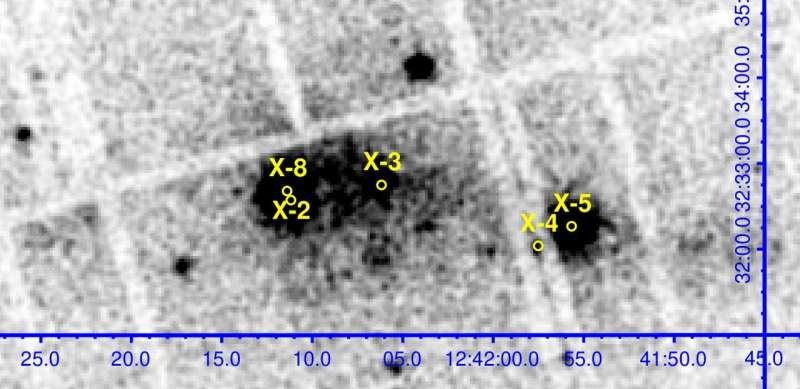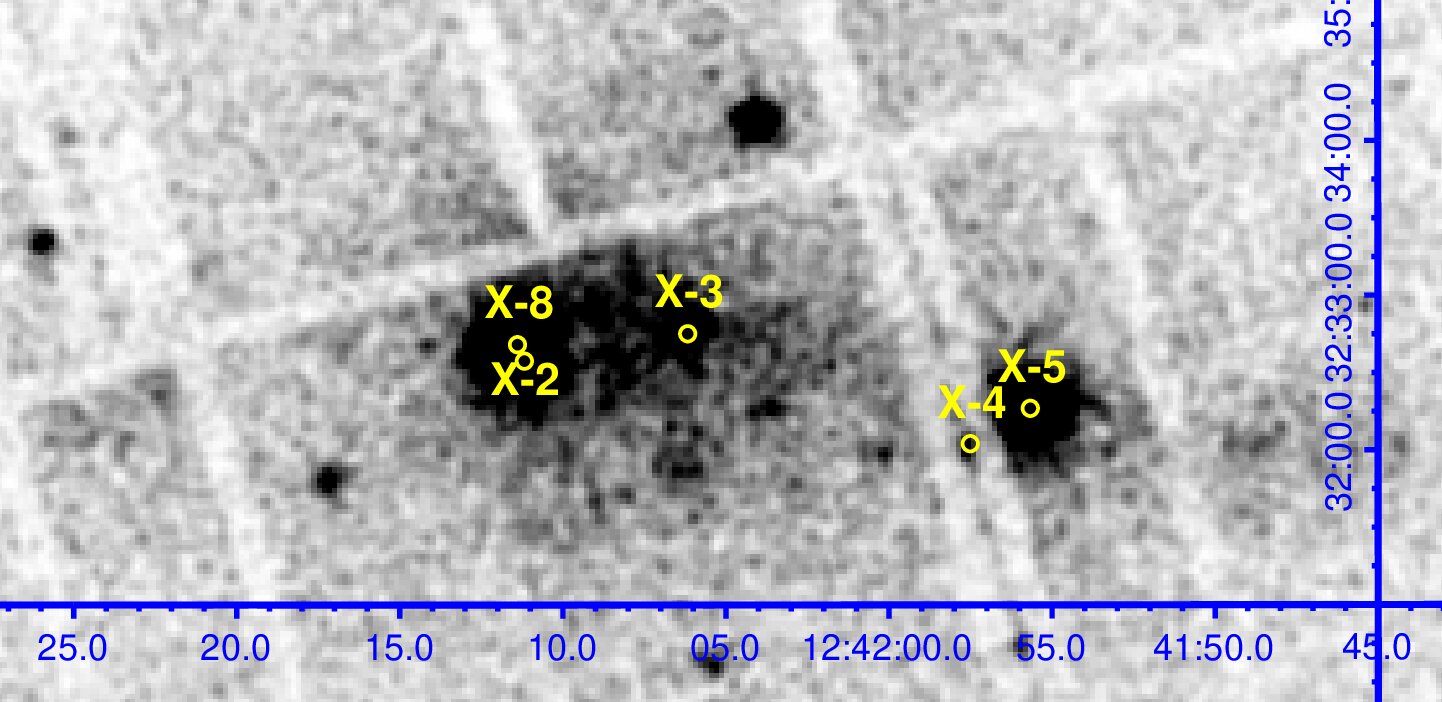
Combined XMM-Newton EPIC image of NGC 4631 in the 0.3–10 keV band from the July 2025 observation. The locations of known ULXs and the new ULX X−8 are marked. Credit: arXiv (2025). DOI: 10.48550/arxiv.2511.04282
Using ESA’s XMM-Newton satellite, European astronomers have observed ultraluminous X-ray sources (ULXs) in the galaxy NGC 4631. As a result, they detected a new pulsating ULX, which received the designation X-8. The research is published November 6 on the arXiv preprint server.
The nature of ULXs still baffles scientists
ULXs are point sources in the sky that are so bright in X-rays that each emits more radiation than a million suns emit at all wavelengths. They are less luminous than active galactic nuclei, but more consistently luminous than any known stellar process. Although numerous studies of ULXs have been conducted, the basic nature of these sources still remains unknown.
Some persistent ULXs exhibit pulsations and therefore are categorized as ultraluminous X-ray pulsars (ULXPs). Discovering and studying objects of this type could be crucial for advancing our understanding of accretion physics—for instance, mechanisms that enable the sustained X-ray luminosities of ULXs which exceed the Eddington limit.
One of many in the Whale galaxy
NGC 4631, dubbed the Whale galaxy, is a late-type starburst galaxy at a distance of some 24.45 million light years, known to host at least seven ULXs. A team of astronomers led by Lorenzo Ducci of the University of Tübingen in Germany, decided to investigate this galaxy in detail with the use of XMM-Newton’s European Photon Imaging Camera (EPIC). Focusing on the ULXs in NGC 4631, they discovered what appears to be a new pulsating ultraluminous X-ray source.
“In this letter, we report the discovery of pulsations from a new ULX located in a crowded region of the galactic disk of NGC 4631,” the researchers wrote.
The observations, carried out in July 2025, identified a significant signal for the period of approximately 9.66 seconds from a new source very close to the previously known ULX designated X−2. The new source received the designation X-8 and turned out to be brighter than X−2, with an X-ray luminosity at a level of 3.4 duodecillion erg/s.
Speeding up and pulsating
The observations found that X-8 has a spin period derivative of about −9.6 × 10−8 seconds/second. Therefore, X−8 shows one of the most rapid spin-up rates observed in pulsating ULXs, with a spin-up timescale (spin period/spin period derivative) of only 3.2 years.
The astronomers noted that such a high spin-up rate of X-8 could originate from orbital motion of the pulsar, accretion torque on the neutron star, or a combination of both mechanisms.
The study also found that the magnetic field strength of the newfound ULXP should be within a range of 10–200 trillion Gauss, which is consistent with the magnetic field strengths inferred by other pulsating ultraluminous X-ray sources.
Summing up the results, the authors of the paper underscored the importance of their discovery in the context of super-Eddington luminosities studies.
“This new ULX pulsar adds a key source to the small known population, and will enable future studies to better constrain the physical mechanisms responsible for their super-Eddington luminosities,” the scientists concluded.
Written for you by our author Tomasz Nowakowski, edited by Gaby Clark, and fact-checked and reviewed by Robert Egan—this article is the result of careful human work. We rely on readers like you to keep independent science journalism alive.
If this reporting matters to you,
please consider a donation (especially monthly).
You’ll get an ad-free account as a thank-you.
More information:
L. Ducci et al, Discovery of a 9.67-s pulsar in an ultraluminous X-ray source in NGC 4631 with XMM-Newton, arXiv (2025). DOI: 10.48550/arxiv.2511.04282
Journal information:
arXiv
© 2025 Science X Network
Citation:
Astronomers discover new pulsating ultraluminous X-ray source (2025, November 12)
retrieved 12 November 2025
from https://phys.org/news/2025-11-astronomers-pulsating-ultraluminous-ray-source.html
This document is subject to copyright. Apart from any fair dealing for the purpose of private study or research, no
part may be reproduced without the written permission. The content is provided for information purposes only.
